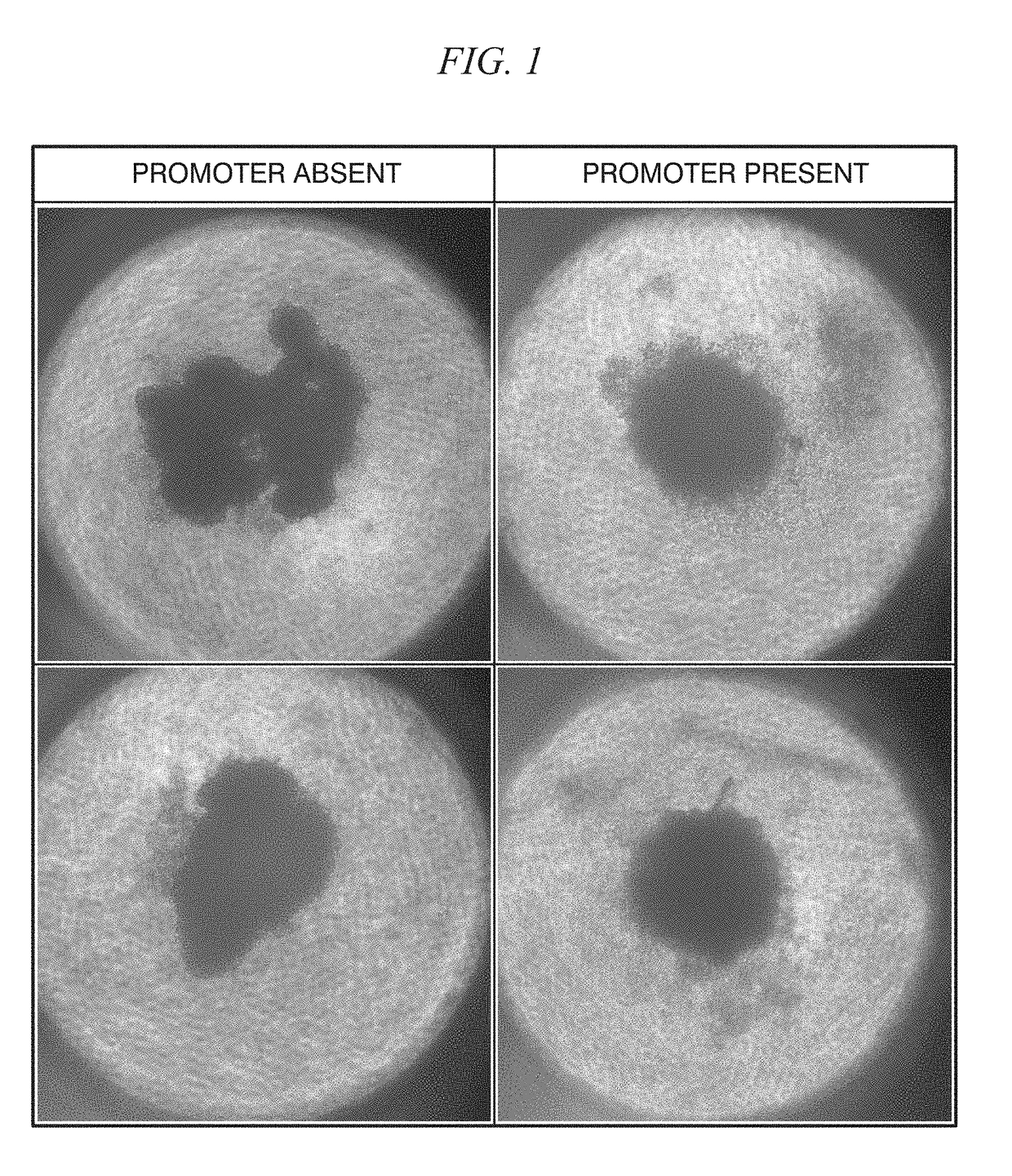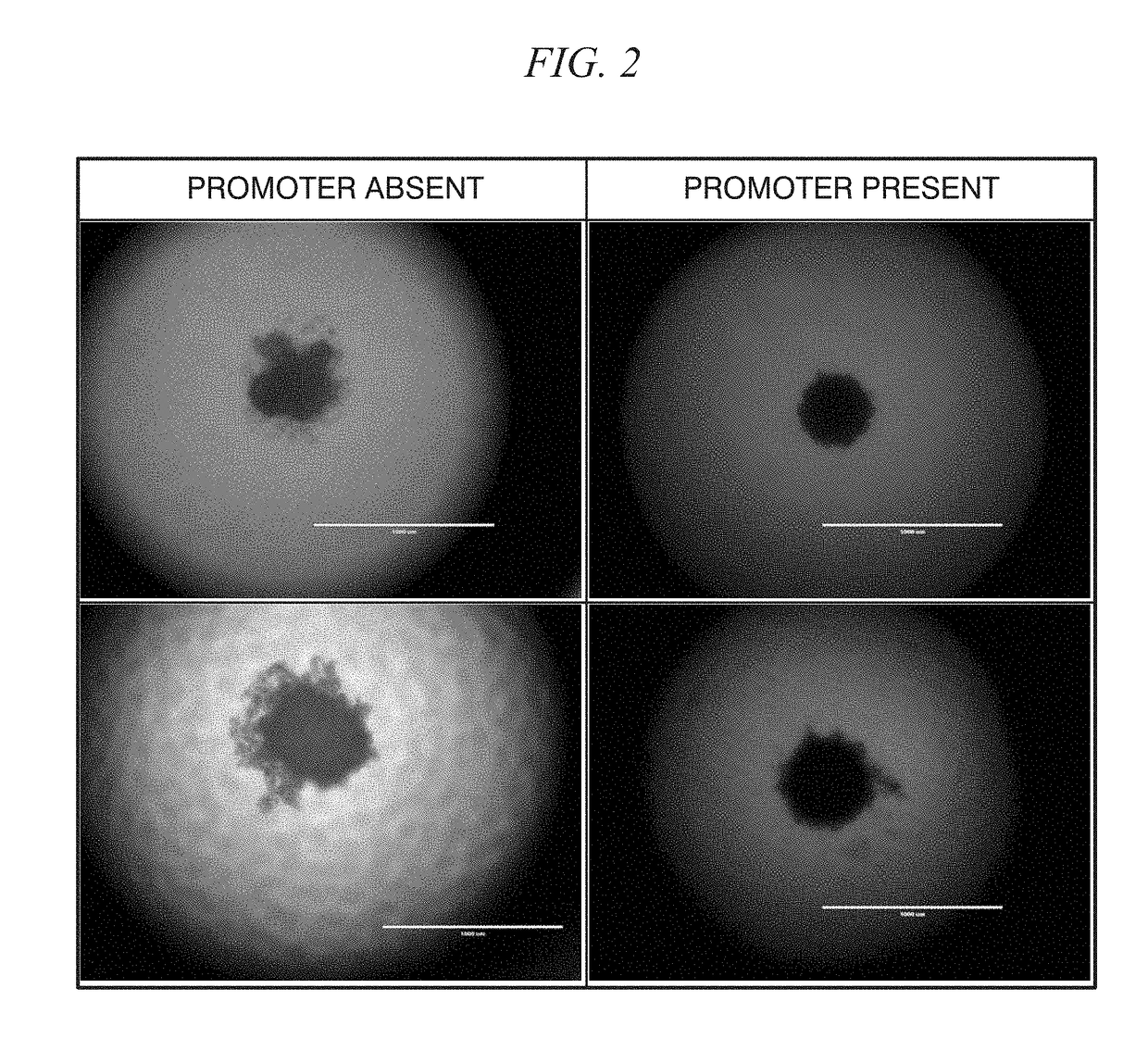Method of promoting spheroid formation
a spheroid and formation method technology, applied in the field of promoting spheroid formation, can solve the problems of inability to form depending on the kind of cells, limited specimens that can be used, and difficult control, so as to promote spheroid formation, promote spheroid formation, and promote spheroid formation. rapid and stable manner
- Summary
- Abstract
- Description
- Claims
- Application Information
AI Technical Summary
Benefits of technology
Problems solved by technology
Method used
Image
Examples
example 1
[0053]A spheroid formed from one kind of cell was formed. As the cells, two kinds of cells, that is, a human colon adenocarcinoma cell line HT29 (HTB-38 (registered trademark) of ATCC (American Type Culture Collection)) as a cell for easily forming a spheroid, and a human mammary gland cancer cell line MCF7 (HTB-22 (registered trademark) of ATCC) as a cell for hardly forming a spheroid were used. As the culture vessel, PERFECTA 3D Biomatrix Hanging Drop Plate (manufactured by 3D Biomatrix corporation, NT-HDP1096) which is a culture vessel in a micro liquid was used. As the culture medium, a serum culture medium in which 10 vol / vol % bovine serum (manufactured by Corning Inc., #35-010-01) and 1 vol / vol % penicillin / streptomycin (manufactured by Waco Pure Chemical Industries, Ltd., 168-23191) are contained in D-MEM (manufactured by Waco Pure Chemical Industries, Ltd., 043-30085) was used. As the promoter, heparin (manufactured by SIGMA Corporation. H3149) was used.
[0054]Specifically, ...
example 2
[0062]A spheroid formed from three kinds of cells was formed.
[0063]As the cells, three kinds of cells, that is, HT29 cells used in Example 1 as well, skin fibroblasts derived from a human newborn (manufactured by Lonza. Group, CC-2509 Normal Human Dermal Fibroblasts: NHDF), and human umbilical vein endothelial cells (manufactured by Lonza Group, CC-2517A Human Umbilical Vein Endothelial Cell: HUVEC) were used.
[0064]Specifically, in the same manner as in Example 1 except that a cell mixture obtained by mixing HT29 cells, NHDF cells, and HUVEC cells at 20,000: 12,000: 8,000 (number of cells) was used as the cells, a cell suspension to which heparin was mixed was prepared, and cultured in a culture vessel in a micro liquid for 72 hours. In addition, in the same manner as in Example 1, spheroid formation in the cell suspension was evaluated over time, and survival rates of the cells after culture for 72 hours was examined. For comparison, the same operation was carried out under a condi...
example 3
[0069]Under a condition in which external force is applied after addition of a promoter and before culture, a spheroid formed from one kind of cell was formed.
[0070]As the cells, MCF7 used in Example 1 as well was used. As the culture vessel, a low cell adsorption plate GravityTRAP (registered trademark) ULA Plate (manufactured by Insphero Inc., ISP-09-001) was used. As the culture medium, the serum, culture medium used in Example 1 as well was used, and as the promoter, heparin used in Example 1 as well was used.
[0071]Specifically, first, in the same manner as in Example 1, heparin and the cells were mixed with a serum culture medium to prepare a cell suspension. Subsequently, the prepared cell suspension was added to each of three wells of a low cell adsorption plate in an amount of 50 μL per well (number of cells per well is 1×104 cells), and then the low cell adsorption plate was subjected to centrifugal treatment for one minute at 400×g. After that, the low cell adsorption plat...
PUM
 Login to View More
Login to View More Abstract
Description
Claims
Application Information
 Login to View More
Login to View More - R&D
- Intellectual Property
- Life Sciences
- Materials
- Tech Scout
- Unparalleled Data Quality
- Higher Quality Content
- 60% Fewer Hallucinations
Browse by: Latest US Patents, China's latest patents, Technical Efficacy Thesaurus, Application Domain, Technology Topic, Popular Technical Reports.
© 2025 PatSnap. All rights reserved.Legal|Privacy policy|Modern Slavery Act Transparency Statement|Sitemap|About US| Contact US: help@patsnap.com


